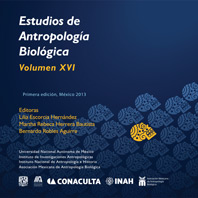Nueva estrategia en la estimación de la edad a la muerte: aplicación histomorfológica en la arqueología de las Tierras Bajas Mayas y un estudio de caso del sitio arqueológico de Copán, Honduras
DOI:
https://doi.org/10.22201/iia.14055066p.2013.56686Palabras clave:
histomorfología, bioarqueología, dinastía, maya, Copán, HondurasResumen
La estimación cronovital de osamentas deterioradas constituye uno de los retos más importantes y, a la vez, difíciles que la antropología física debe resolver en restos humanos arqueológicos, especialmente en la arqueología de las Tierras Bajas Mayas que sufre el acelerado deterioro de todo tipo de material orgánico, incluyendo restos humanos. El presente trabajo introduce una nueva estrategia de la estimación microscópica de la edad a la muerte que se adecua a las condiciones de destrucción que ahí imperan. El procedimiento de análisis incluye tres componentes: los conteos selectivos de osteones por área para obtener la densidad de osteones (opd), el área cortical en el corte transversal de costilla y la evaluación cualitativa de las microestructuras en la misma. Los procedimientos histológicos se aplican en el estudio de dos osamentas deterioradas del sitio arqueológico de Copán, Honduras. Los enterramientos fueron encontrados en el céntrico cuadrante 10 J, y sus ofrendas permiten considerar a uno de ellos como miembro de la dinastía local copaneca. En ambos casos, nuestros resultados mejoran las determinaciones convencionales y brindan nuevas perspectivas para el análisis de restos deteriorados.
Descargas
Descargas
Publicado
Cómo citar
Número
Sección
Licencia

http://creativecommons.org/licenses/by-nc-nd/4.0/


